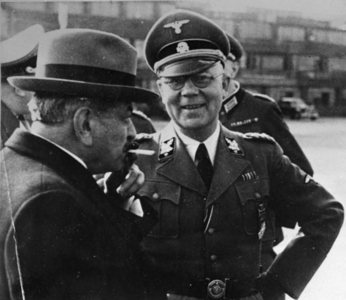Carl Oberg
| Carl Albrecht Oberg | |
|---|---|
 Pierre Laval (left) and Carl Oberg in Paris | |
| Born |
27 January 1897 Hamburg |
| Died |
3 June 1965 (aged 68) Flensburg |
| Occupation | Nazi official |
| Criminal penalty | Sentenced to death by hanging, commuted to life imprisonment, later released |
| Motive | Nazism |
| Conviction(s) | Crimes against humanity |
Carl Oberg (27 January 1897 – 3 June 1965) was a German SS functionary during the Nazi era. He served as the Higher SS and Police Leader (HSSPF) of France during the Second World War. Oberg deported over 40,000 Jews from France. After the war, he was twice sentenced to death by two different courts. However, in 1958 the death sentence was commuted to life imprisonment and later reduced to 20 years hard labour. Oberg was pardoned and released on 28 November 1962.
Nazi career
He joined the NSDAP (Nazi Party) on 1 April 1931 and the SS on 7 April 1932. After meeting Reinhard Heydrich in May 1933, he asked Heydrich for a job and joined the SD. Oberg was later promoted to an SS-Oberführer and made the police administrator for Hanover. He served in that capacity from September 1938 until January 1939. Next, Oberg served as Police President of Zwickau until late 1941. He served as SS-und Polizeiführer (SS and Police Leader - SSPF), "Radom" from August 1941 to May 1942. Oberg was promoted to SS-Brigadeführer on 20 April 1942.[1]
From May 1942 to November 1944, Oberg served as Higher SS and Police Leader (Höherer SS-und Polizeiführer, HSSPF) "Frankreich" (France) overall German police forces in France, including the SD and Gestapo. He was the supreme authority in France for managing anti-Jewish policy and the battle against the French Resistance. He thus drove the rounding up of Jews in the Paris Vélodrome d'Hiver (Vel' d'Hiv Roundup) in 1942. By that time he had been condemned as the "Butcher of Paris".[2] On Heydrich's orders, Oberg deported over 40,000 Jews from the country with the assistance of the Vichy France police force headed by René Bousquet.[3][4][5]
By 1943, however, he was resisting some of the orders issued by Himmler and Hitler. On 18 January Himmler demanded a cleansing of Marseilles with 100,000 arrests and explosive demolition of the city's crime district. Working with the French police, Oberg supervised a "minimalist" response of 6,000 arrests, 20,000 people displaced, and partial destruction of the harbour area.[6] In 1944, Oberg blocked an attempt to establish an Einsatzkommando of the Waffen-SS in France.[7]
Post-war trial, sentence, and reprieve
Oberg was arrested by the US military in June, 1945 and sentenced to death by a British court before receiving another death sentence from the French in October, 1954. In 1958, the sentence was commuted to life by French President René Coty, and later reduced to 20 years hard labor.[8] Oberg was pardoned by President Charles de Gaulle and released on 28 November 1962.[1]
Notes
- 1 2 Yerger (1997), p 103.
- ↑ https://books.google.ca/books?id=p9m5JE0B324C&pg=PA159&dq=oberg+butcher+of+paris&hl=en&sa=X&ved=0ahUKEwj77M7mqpTVAhUJ4oMKHcCwDH0Q6AEIODAD#v=onepage&q=oberg%20butcher%20of%20paris&f=false, p=159
- ↑ https://books.google.ca/books?id=1LeGAgAAQBAJ&pg=PA198&dq=rene+bousquet+Heydrich+and+Himmler&hl=en&sa=X&ved=0ahUKEwjGo6npvpPVAhWZ0YMKHYzJB0A4ChDoAQhIMAU#v=onepage&q=rene%20bousquet%20Heydrich%20and%20Himmler&f=false, p=198
- ↑ Yerger (1997), pp 51, 103.
- ↑ https://books.google.ca/books?id=Q7ORlIpHKLEC&pg=PA244&lpg=PA244&dq=oberg+bousquet+vichy+france&source=bl&ots=6bDDh8itd6&sig=_ONJgTk1e4LZNwGdXbgE84PrTAM&hl=en&sa=X&ved=0ahUKEwjc8amxpJTVAhXp54MKHUebBw0Q6AEIYTAK#v=onepage&q=oberg%20bousquet%20vichy%20france&f=false, p=244-245
- ↑ https://books.google.ca/books?id=GBQchepZ-7EC&pg=PA651&dq=oberg+marseilles+jews++arrests&hl=en&sa=X&ved=0ahUKEwiemJWKppTVAhUp5oMKHT3oDVMQ6AEIPzAE#v=onepage&q=oberg%20marseilles%20jews%20%20arrests&f=false, p=651
- ↑ Longerich (2012), pp 650-653
- ↑ Time (1958).
References
- (in German) Birn, Ruth Bettina, Die höheren SS- und Polizeiführer. Himmlers Vertreter im Reich und in den besetzten Gebieten Düsseldorf 1986 (Seite 252ff, 341)
- (in German) Lappenküper, Ulrich Der "Schlächter von Paris". Carl-Albrecht Oberg als Höherer SS- und Polizeiführer in Frankreich (1942-1944) in: Deutschland und Frankreich im Krieg (Nov. 1942 - Herbst 1944). Okkupation, Kollaboration, Résistance Hg. S. Martens, M. Vaisse, Bonn: Bouvier, 2000 (Seite 129-143)
- (in German) Die faschistische Okkupationspolitik in Frankreich (1940-1944) Dokumentenauswahl. Hg. und Einl. Ludwig Nestler. Berlin: Deutscher Verlag der Wissenschaften, 1990 (Orts-, Personenregister) ISBN 3-326-00297-1 (zahlreiche Einträge im Index)
- (in German) Weiß, Hermann (Hrsg.): Biographisches Lexikon zum Dritten Reich, Frankfurt 2002 ISBN 3-596-13086-7
- Longerich, Peter (2012). Heinrich Himmler. Oxford, UK: Oxford University Press. ISBN 978-0-19-965174-0.
- Yerger, Mark C. (1997). Allgemeine-SS: Commands, Units and Leaders of the General SS. Atglen, PA: Schiffer Publishing. ISBN 0-7643-0145-4.
- "Sparing the Butcher's Life". Time. 5 May 1958. Retrieved 17 September 2011.